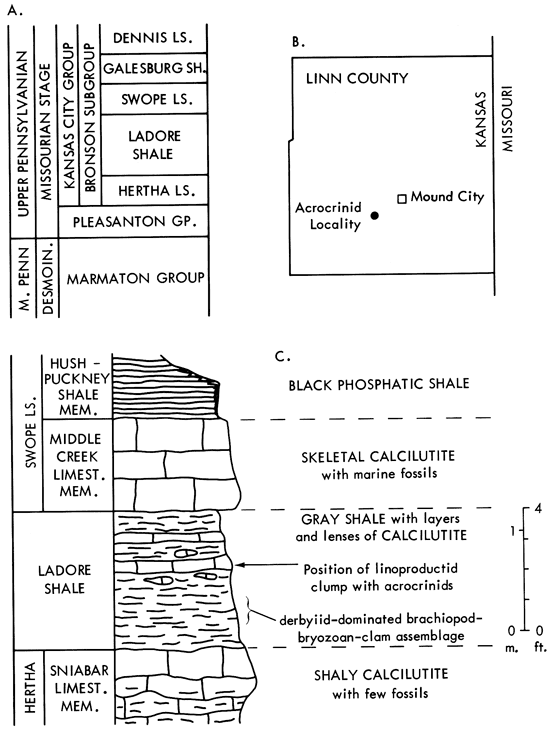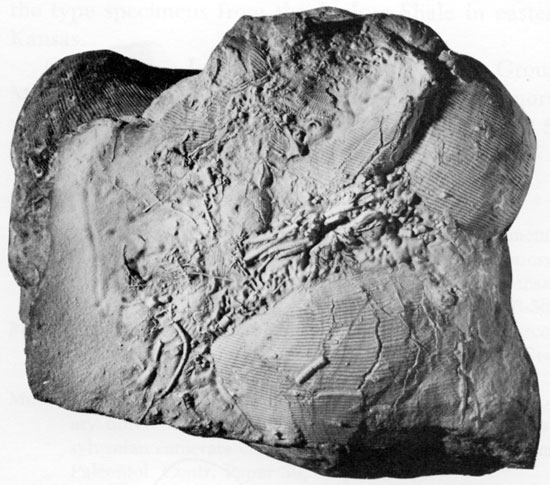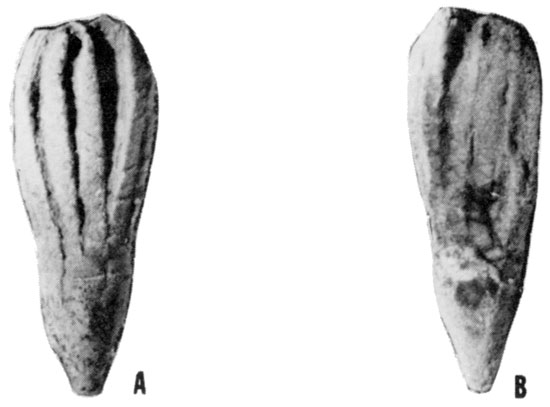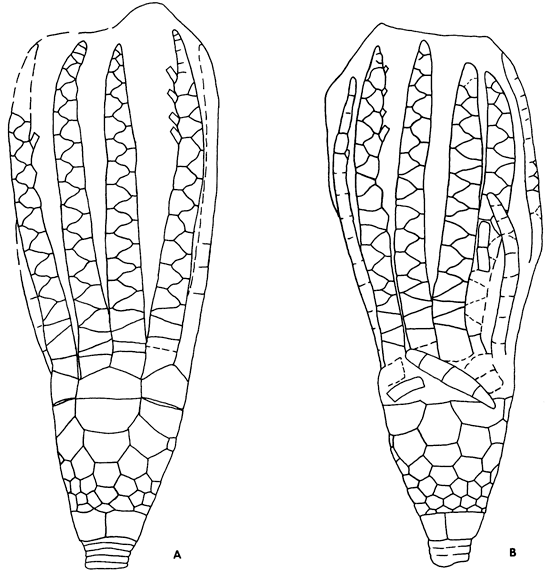
Kansas Geological Survey, Bulletin 211, Part 4, p. 5-9
A rare camerate crinoid, Planacrocrinus klapperi n. sp., has been found in close association with a clump of linoproductid brachiopods in the Ladore Shale in Linn County, Kansas. This is the first recording of the complete crown of any species of Planacrocrinus. The arms are remarkably similar to those of more common inadunate crinoids.
Only a remnant of the vast hordes of camerate crinoids that existed in Early and Middle Mississippian time survived into the Pennsylvanian. Of these the Acrocrinidae are the most common. Nevertheless, compared to the inadunate and flexible crinoids in Pennsylvanian rocks, acrocrinids are quite rare and small in size. In any event, acrocrinids are an enigma in that they are the only group among all crinoids in which the cup increases in length throughout life by the intercalation of plates between radials and basals. Newly formed intercalaries appear along the distal rim of the basal circlet and are both radial and interradial in position. It appears that acrocrinids evolved from dichocrinids through Protacrocrinus Moore & Strimple, 1969, of Kinderhookian (Early Mississippian) age.
Of all the unusual modifications adopted by the acrocrinids, perhaps the most unexpected is development of a radial articular facet resembling those of such inadunate crinoids as Erisocrinus and Delocrinus, wherein the facet occupies full width of the plate, extending well inward from the outer margin and possessing ligament fossae, transverse ridge, muscle attachment areas and intermuscular notch. These features have been reported for Planacrocrinus Moore & Strimple (1969, p. 15, fig. 6, 8) and Platyacrocrinus Moore & Strimple (1969, p. 10, fig. 4) from the Lower Pennsylvanian (Morrowan). These are the only genera of the entire class Camerata to have developed this type of radial articular facet. A detached set of arms was designated as a paratype of Planacrocrinus knappi Strimple (1975, fig. 17, 1) from the Burgner Formation (Atokan) of Missouri; however, assignment to the species was made on the basis of crowns of the new undescribed specimens from the Ladore Shale of Kansas, which are herein described as P. klapperi. This new discovery extends the range of Planacrocrinus into the lower part of the Missourian Stage, the lower stage of the Upper Pennsylvanian Series.
The Ladore Shale in central Linn County, Kansas, is 4 to 5 feet (1.2-1.5 m) of sandy calcareous gray shale that carries thin layers of argillaceous calcilutite in the upper part (Fig. 1). The only common and conspicuous fossils in the Ladore in this region occur in the lower part at the acrocrinid locality and constitute an assemblage of brachiopods, rhomboporid bryozoans and bivalves strongly dominated by the brachiopod Derbyia. Other identified brachiopods in this assemblage include Neospirifer and a dictyoclostid. The acrocrinids were found in a clump of linoproductid brachiopods (Fig. 2) that was collected above the derbyiid assemblage in the lower of two thin calcilutite layers in the Upper Ladore. The only other fossil material in either limestone layer consists of rare and scattered tiny gastropods, echinoderm ossicles, ostracodes and a probable bivalve fragment, all noted in thin section. Slight color mottling suggests some burrowing of the substrate.
Figure 1--Location of acrocrinid collection. A. Position of Ladore Shale in Upper Pennsylvanian sequence of eastern Kansas. B. Linn Co., Kansas, showing acrocrinid locality about 2 miles ( 3 km) southwest of Mound City. C. Measured section of Ladore Shale at acrocrinid locality on north side of Kansas Hwy. 52, in NE SW sec. 23, T. 22 S., R. 23 E.

Figure 2--Cluster of linoproductid brachiopods with stems and crowns of Planacrocrinus klapperi n. sp. (SUI 43157) on upper surface. Holotype of P. klapperi has been removed and is illustrated elsewhere.

Within the Kansas cyclic sequence, the Ladore is an "outside shale member" deposited during a period of general marine regression between the widespread inundations that gave rise to the Hertha and Swope Limestones (Heckel and Baesemann, 1975, p. 493). Although "outside shales" locally contain nonmarine deposits, many of them in eastern Kansas were deposited in nearshore portions of a sea that was merely reduced in size and subject to greater detrital influx than during more inundative phases. Thus, these acrocrinids lived in a marine environment that received enough mud influx that the turbid water and soft substrate was unfavorable to most sessile organisms. This, along with detrital dilution, accounts for the general scarcity of fossils in most of the Ladore. Only when the clump of several linoproductid brachiopods became established on the sea bottom was a local area of substrate favorable for growth of the acrocrinids.
P. klapperi is represented by three small crinoids which have articulated stalks (columns) and arms. One specimen (Fig. 3, 4), the holotype (SUI 35580), which has been removed from the shaly matrix of the clump, is a perfect crown with the proximal portion of the column attached. There is little doubt that the crinoids were living in association with the linoproductid brachiopods, which probably bad formed a tiny mound above the muddy substrate. Because crinoids are filter feeders, they require relatively good water circulation. Very likely these acrocrinids benefited from the mini-currents set up by the several linoproductids as well as from the more stable substrate that the large brachiopods offered. The only other instance of intimate association between large brachiopods and crinoids known to us is in an exposure of the Barnett Hill Member, Atoka Formation, Atokan Stage (Middle Pennsylvanian) in Coal County, Oklahoma, in which the matrix is weakly calcareous sandstone, heavily impregnated with iron oxide. Specimens of Oklahomacrinus, Stellarocrinus, Elibatocrinus, Isollagecrinus and other genera have been found embedded with, and even inside, disarticulated valves of productids. It seems that both the Kansas and Oklahoma occurrences were buried by a rapid influx of mud that entombed the crinoids instantly and protected them from the ravages of scavengers. Complete disarticulation of the myriad of plates forming the endoskeletons of crinoids is known to take place in a matter of several days if they are left exposed on the sea floor after death (Meyer, 1971).
Class CRINOIDEA Miller, 1821
Subclass CAMERATA Wachsmuth & Springer, 1885
Order MONOBATHRIDA Moore & Laudon, 1943
Superfamily HEXACRINITACEA Wachsmuth & Springer, 1885
Family ACROCRINIDAE Wachsmuth & Springer, 1885
Subfamily ACROCRININAE Wachsmuth & Springer, 1885
Genus PLANACROCRINUS Moore & Strimple, 1969
Type species. Planacrocrinus ambix Moore & Strimple, 1969, p. 15.
Diagnosis (after Moore & Strimple, 1969). Calyx flat at base and summit, bowl-shaped to subconical with steep nearly straight sides, basals clearly visible in side view; radials wider than high, with straight articular facets occupying full width of plates and extending well inward from outer margin, resembling facets of such inadunate crinoids as Delocrinus and Cromyocrinus in presence of ligament fossae, transverse ridge, muscle-attachment areas, and intermuscular notch; C and D radials separated by hexagonal primanal which is widest in lower third and narrowest at summit slightly below level of radial facets or even with them; circlet of distal-most intercalaries composed of eight plates, only A radial having one directly beneath it.
Discussion. As noted in the diagnosis above, the radial articular facets are similar to those of many inadunate crinoids. The arms of P. klapperi, n. sp. are remarkably similar to those of the inadunate crinoid Erisocrinus.
Occurrence. Lower Pennsylvanian (Morrowan)-Upper Pennsylvanian (Missourian), USA (Oklahoma, Missouri, and Kansas).
Text figs. 2-4
Diagnosis. Similar to Planacrocrinus conicus Moore & Strimple, 1969, in essential structural features of the calyx other than for the anal series in CD interray, which is continuous in P. conicus. In P. klapperi the two proximal subanals are separated by intercalaries and the distal-most anal plate (primanal) has a broader summit face than found in P. conicus.
Ten arms branch with broad axillary primibrachs 1 in all rays. Lowermost secundibrachs cuneate but soon become interlocking (equi-biserial). Secundibrachials are pinnular bearing.
Measurements of holotype of P. klapperi in millimeters: height of crown 11.2, height of calyx 3.0,, width of calyx 2.8, width of stem at calyx 1.0.
Discussion. The steep straight sides of calyx and numerous intercalaries serve to distinguish P. klapperi from P. ambix and P. minutus Moore & Strimple, 1969. In addition to differences previously discussed, P. klapperi has proportionately taller basals than found in P. conicus. P. klapperi has an uninterrupted series of anal plates, shorter basals and a broader calyx, all of which distinguish the species from P. klapperi.
Types. Holotype SUI 35580, paratypes SUI 42157, deposited in Geology Department Repository, The University of Iowa, Iowa City, Iowa 52242.
Etymology of name. The species name klapperi is proposed in honor of Gilbert Klapper, who collected the type specimens from the Ladore Shale in eastern Kansas.
Occurrence. Ladore Shale, Kansas City Group, Missourian Stage, Upper Pennsylvanian Series; north side of Kansas Hwy. 52 in NE SW sec. 23, T. 22 S., R. 23 E., Linn County, Kansas.Figure 3--Unretouched photographs of holotype (SUI 35580) of Planacrocrinus klapperi n. sp. A. Anterior view of crown, B. Posterior view of crown, X7.6 [Enlarged from published version for web display].

Figure 4--Camera lucida drawings of holotype (SUI 35580) of Planacrocrinus klapperi n. sp. from Ladore Shale of Linn County, Kansas. A. Anterior (A ray) view of crown, B. Posterior (CD interray) view of crown, X7.5.

Heckel, P. H. and Baesemann, J. F., 1975, Environmental interpretation of conodont distribution in Upper Pennsylvanian (Missourian) megacyclothems in eastern Kansas: Am. Assoc. Petroleum Geologists Bull., v. 59, p. 486-509.
Meyer, D. L., 1971, Post mortem disarticulation of Recent crinoids and ophiuroids under natural conditions: Geol. Soc. America, Abst. with Progr., v. 3, no. 7, p. 45-46.
Moore, R. C., and Strimple, H. L., 1969, Explosive evolutionary differentiation of unique group of Mississippian-Pennsylvanian camerate crinoids (Acrocrinidae): Univ. Kans., Paleontol. Contr., Paper 39, 44 p., 24 figs. [available online]
Strimple, H. L., 1975, Middle Pennsylvanian (Atokan) crinoids from Oklahoma and Missouri: Univ. Kans., Paleontol. Contr., Paper 76, 30 p., 17 figs. [available online]
Kansas Geological Survey
Comments to webadmin@kgs.ku.edu
Web version updated June 18, 2010. Original publication date April 1978.
URL=http://www.kgs.ku.edu/Publications/Bulletins/211_4/strimple.html